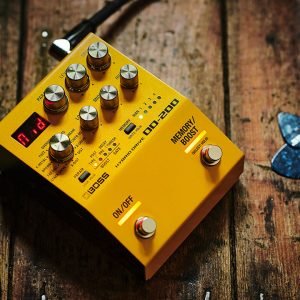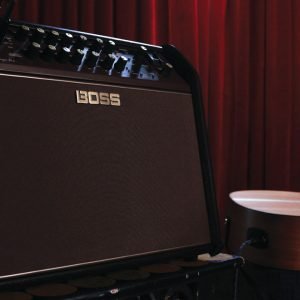Bass Effects
Effects aren’t just for guitar players!
Whether you need a compressor or an octave pedal to bring the funk (and bring the noise), or you’re after a drive pedal for thunderous low-end mayhem –or maybe you just want to groove out with some smooth synth bass – we’ve got something for you.

How to Make Bass Effects Work for You
If you’re playing bass guitar in a band or musical project of any kind, one of the main things you’re probably very aware of, is your tone.
Bass isn’t just bass and “one tone for all” does not suit all bass players. That kind of thinking is not true for guitar players, keyboard players or drummers. Why should it be true for bass players?
You can definitely improve, enhance and compliment your tone as a bass guitarist by using effects pedals. Using bass effects can range from a subtle augmentation to all out tone colouring and can even inspire your playing style! No matter what you want to do, or what you play, there’s a bass effect out there from which you’ll benefit by adding to your rig.
So what’s the difference between bass effects and regular, guitar stompboxes? Glad you asked. It’s all about a bass guitar being a bass guitar.

Can I Use Guitar Pedals On Bass?
When it comes to pedal effects, it’s no secret that it’s a guitarist’s world. While significant advances in bass pedal effects over the years have emerged, the overwhelming majority of stompboxes seem to be guitar-centric. So, as any bass player might (reasonably) ask, can I use pedals designed for a guitar with my bass?
The good news is of course, yes! Absolutely! There are no rules with music. But, it’s important to select the best effect for the job.
BOSS have been making bass-specific pedals for decades now. From crisp and powerful Overdrives, to tried and true Limiters, Compressors and EQs, lush Choruses and dynamic Bass Synths, BOSS have always had bass players in mind when it comes to effects.
The BOSS MS-3 Multi-Effects & the BOSS CP-1X

BOSS Talk: The Science of Bass Overdrive
Use the Science of Bass Overdrive to discover your dream bass overdrive tone! Analysing the aspects of your sound will make your bass tone take centre-stage
A remark guaranteed to annoy any bass player is that the bass guitar is just a guitar with two less strings and twice as easy to play. This statement couldn’t be further from the truth!
Bass guitar (played well!) is one of the most expressive instruments on stage. Fingerstyle or pick, slap, pop or just straight groove playing, the bass guitar is the rhythmic extension of the player. It takes years, decades, if not a lifetime, to truly master the art of bass playing.

5 Ways To Use The BOSS MS-3 Multi-Effects Switcher
First things first. Despite the visual similarity, the MS-3 is not just a smaller version of the popular ES-5 and ES-8 effects switching systems. It’s all in the name – it’s a Multi-Effects unit and pedal Switcher, with 3 loops to integrate your must-have stompboxes.
Let’s break that down a little further.
The MS-3 contains a whopping 112 built-in effects including delays, reverbs, modulation/pitch effects, overdrives, distortions, and more. It’s basically the fully-fledged effects section from a GT-100, crammed into a super-compact enclosure. You can run six of these effects concurrently.


BOSS CP-1X – COMPRESSION REIMAGINED
A stompbox effect staple, compressor pedals have managed to carve out their own certain niche in the guitar playing community.
When used for specific genres, they suit some players perfectly. Country musicians for example, who play those awesome chicken-pickin’ or bluegrass kind of licks discovered the benefits of using a stompbox compressor decades ago.
The sound of a compressor working its charm over Nashville-inspired playing has become crucial to that specific kind of sound. And for a clean guitar tone with a bit of chorus and reverb, a compressor pedal will do sparkling, lush wonders!
Here Are More Articles You May Like

BOSS OD-200 – 4 Ways to High Gain Heaven
The OD-200 Hybrid Drive brings together decades of experience and innovation in overdrive and distortion to create a totally new breed of pedal. The cutting

HOW TO GET THE MOST OUT OF YOUR MS-3 – THE ULTIMATE GUIDE
Let’s start with the concept behind the BOSS MS-3. MULTIEFFECTS We’re all familiar with the concept of a multieffects unit – it’s an all-in-one unit

What Guitar Effects Pedals Do I Need? The Beginner’s Guide
So you’ve just bought an electric guitar and an amp of some sort. Now you’re thinking, those colourful stompbox things look pretty cool – but

Which BOSS Digital Delay? DD-200 vs DD-500
The awesome DD-200 is the newest multi delay from BOSS. If you’ve seen its powerhouse big brother, the DD-500, you might be asking, why would I

4 REASONS WHY YOU NEED AN EQ PEDAL
On the face of it, an EQ pedal may seem pretty redundant – it technically doesn’t make any sound in and of itself, and you

How Can I Get Started? Home Recording for Electric Guitar
It’s really might be the best era to be a guitar player. Technology has made almost every aspect of playing guitar so much more convenient.

Getting Started With Your BOSS Acoustic Singer Amp
The BOSS Acoustic Singer series of amplifiers is designed for the guitarist/vocalist who needs one self-contained unit for handling all of their amplification needs; acoustic

How To Amplify Your Acoustic To Play Live
So you’ve honed your acoustic guitar chops, and you want to take your playing to the stage! Acoustic guitars sound great, but by their very

Brett Kingman BOSS KATANA MkII Patch Collection
Brett Kingman is a professional guitar player who has toured with many icons of Australian music – but you may know him better as one

Metal Zone – You’re Using It Wrong
It’s funny – everyone has an opinion on the trusty ol’ Metal Zone. And we think we know why – it’s because almost everyone has

The 4 Cable Method (4CM) – What It Is and How To Use It Correctly
The 4 Cable Method (4CM), is a term usually heard in guitar-related conversations. It describes a way to connect your guitar to your effects pedals and

Which Headphones Are Right For Me?
Headphones are one of the greatest technological creations of the 20th century. If you don’t think that’s true, take a look in any bus, train,

How to Make Bass Effects Work for You
Why Do I Need Bass Effects For My Bass Playing? If you’re playing bass guitar in a band or musical project of any kind, one

5 Reasons To Add The DM-2W To Your Pedalboard
Upgrade Your Tone with a Waza Craft Analog Delay For a long time, savvy guitar players have known about the special magic that the vintage BOSS DM-2

BOSS Tuners: A Lesson in Fine-Tuning
If you’re a musician and have been around for a while, chances are you’ve seen or owned a BOSS Tuner. Maybe you’ve come across one of

Shades of Time – What The BOSS DD-500 Digital Delay Can Do For You
The BOSS DD-500 Digital Delay is BOSS’ flagship, multi-mode delay pedal. With exceptional sound quality and customisable flexibility, the DD-500 is an absolute powerhouse of

BOSS SY-300 Guitar Synthesizer vs. ROLAND GR-55 Guitar Synthesizer
For over 35 years, Roland guitar synthesizers have provided guitar and bass players with the means to coax astonishing sounds from their instruments. There’s something

The Ultimate Guide to the BOSS ES-5 Effects Switching System
The BOSS ES-5 Effects Switching System is the newer, smaller brother to the remarkably successful ES-8. Since its 2015 release, the BOSS ES-8 Effects Switcher



